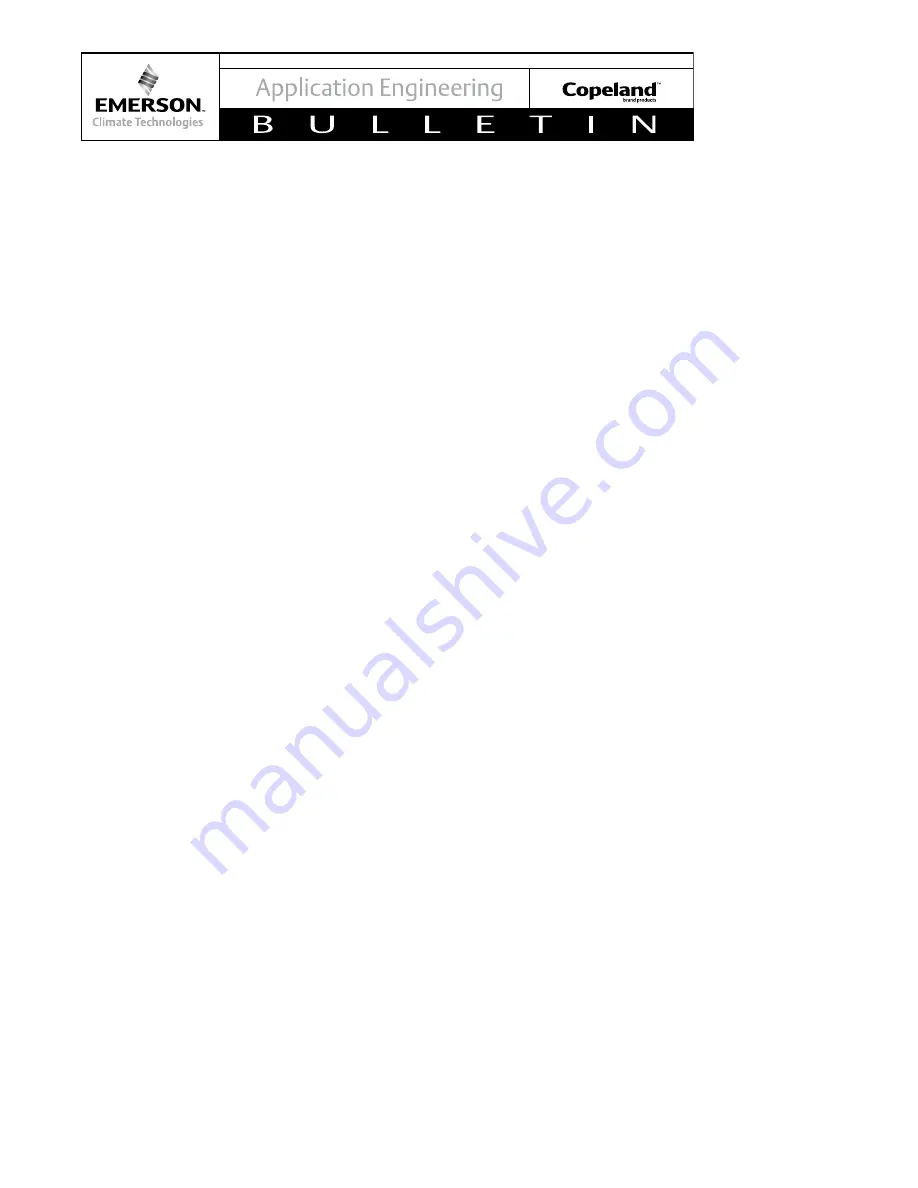
10
© 2016 Emerson Climate Technologies, Inc.
AE4-1402 R4
after the compressor is turned off.
Accumulators
The use of accumulators is very dependent on the
application. The variable speed scroll has an inherent
ability to handle liquid refrigerant during occasional
operating flood back situations. Systems designed
with EXV or TXV refrigerant control may not require
an accumulator if testing assures the system designer
that there will be no flood back throughout the
operating range. To test for flood back conditions and
to determine if the accumulator or EXV/TXV design is
adequate, please see the
Application Tests
section.
A large-area protective screen no finer than 30x30
mesh is required to protect this small orifice from
plugging. Tests have shown that a small screen with
a fine mesh can easily become plugged causing oil
starvation to the compressor bearings. The size of
the accumulator depends upon the operating range
of the system and the amount of system refrigerant
charge. System modeling indicates that heat pumps
that operate down to and below 0°F (-18°C) will require
an accumulator that can hold around 70% to 75% of
the system charge. Behavior of the accumulator and
its ability to prevent liquid slugging and subsequent oil
pump-out at the beginning and end of the defrost cycle
should be assessed during system development. This
will require special accumulators and compressors
with sight tubes and/or sight glasses for monitoring
refrigerant and oil levels.
Off-Cycle Migration Control
Off-cycle migration control is important for long term
compressor reliability and to minimize nuisance
complaints associated with flooded start conditions.
Off-cycle migration control is recommended when
the system charge exceeds 15.0 lbs (7 kg). Off-
cycle migration control is required when the system
charge exceeds 18 lbs (8 kg). In lieu of using a
conventional wrap-around crankcase heater, the drive
has a programmable feature that will utilize the motor
windings.
If off-cycle migration control is required, and no off-
cycle migration testing across the range of expected
indoor/outdoor temperatures is performed, the stator
heater must be powered to at least 100 Watts when
the compressor is 'off'. To use fewer than 100 Watts or
to comply with future DOE requirements for off-cycle
power consumption, off-cycle migration testing must
be performed. A 70 watt crankcase heater may be
used instead of the motor windings to provide heat
to the base.
CAUTION Stator heat for off-cycle migration must
not be energized when the system is in a vacuum
or if there is no refrigerant charge in the system.
The system low pressure cut-out control can be
used as an indicator of the presence of refrigerant
charge.
Manifolded Compressors
Multiple compressor assemblies are available for
purchase from Emerson. In lieu of purchasing the
assembled manifold, the OEM can choose to purchase
the manifold-ready compressor and perform the
assembly in their factory. Drawings of tandem and trio
compressor assemblies are available from Emerson
Climate Technologies by contacting your Application
Engineer.
NOTICE: Customers who choose to
design and build their own manifolds for tandem
and trio compressor assemblies are ultimately
responsible for the reliability of those manifold
sets.
The suction manifold is close to a symmetrical layout
with the design intent of equal pressure drop to each
compressor. A straight length of pipe is connected to
the suction manifold "T" connection to serve as a flow
straightener to make the flow as uniform as possible.
The discharge manifold is the less critical of the two
manifolds in terms of pressure drop. Low pipe stress
and reliability are its critical design characteristics.
Support for the discharge manifold between the
compressors should be no closer than a straight
distance of 14" (356 mm) from the discharge tee.
For tandem compressor applications, tubing stress
levels should be closely evaluated between a
frequency of 29 and 35 Hz. If excess stress levels
occur, the Resonance Avoidance Feature in the
Emerson EVC1 drive may be used.
Manifolded Applications
Manifolded compressors follow the same application
guidelines as single compressors outlined in this
bulletin. The refrigerant charge limit for manifolded
compressors is shown in
Table 4
. A manifolded circuit
with charge over the limit must have a crankcase
heater or stator heating applied to both compressors.
Oil levels in the individual sight-glasses will vary,
depending on whether one or more compressors in the









































